13 Digital Marketing Trends Every Indian Brand Must Watch in 2026
India’s Digital Marketing Landscape in 2026
If 2025 was the year Indian brands learned to play with digital transformation, 2026 is the year they’ll have to master it.
India’s online population is expected to cross 900 million users by the end of the year, digital ad spending is set to exceed ₹75,000 crore, and AI is no longer a buzzword – it’s the backbone of how campaigns are built, optimized, and personalized. The digital battlefield is noisier, faster, and far less forgiving.
What used to be marketing experimentation is now marketing infrastructure. Algorithms write ad copy, consumers shop directly through Reels, and even small-town businesses are running performance campaigns in Hindi, Tamil, and Gujarati. The Indian internet is no longer urban or English – it’s everywhere and everyone.
For founders, CMOs, and digital strategists, staying ahead means more than knowing the latest tools. It’s about understanding the shifts in consumer behaviour, content ecosystems, and AI-driven platforms that are quietly rewriting the rules of engagement. That’s why understanding the trends shaping 2026 isn’t just about following fads. It’s about spotting the structural shifts – AI-driven search, short-form video dominance, vernacular-first content – that will define winners and losers in the next 12 months
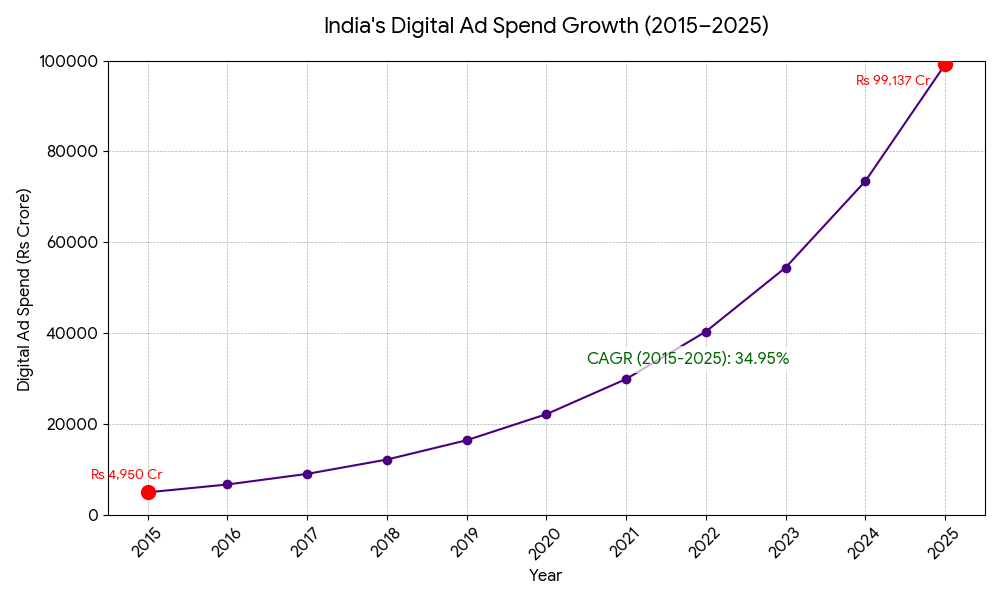
Trend 1: Generative SEO (GEO) Takes Over Search
For years, SEO in India was about backlinks, keyword density, and fighting for the coveted “position zero” in Google snippets. That playbook is officially outdated. Enter Generative SEO (GEO) – the art of optimizing for Google’s Search Generative Experience (SGE) and AI-powered query results.
Here’s the shift: instead of showing a list of links, Google now synthesizes answers. Users ask a conversational question, and the AI gives them a context-rich response—often pulling from multiple sources at once. In other words, your content is no longer competing for a click. It’s competing for inclusion in an AI-generated summary.
For Indian brands, this changes the game.
- Conversational Queries: Instead of ranking for “best smartphones under 20k,” you’ll need content that answers: “Which phone under 20k has the best camera for night photography?”
- Intent > Keywords: Google’s SGE looks for context – tone, authority, and relevance to the user’s intent.
- Rich Media Wins: Articles that integrate explainer videos, FAQs, and structured data are more likely to be cited in generative answers.
👉 What this means for you: Indian brands must start creating content clusters that address intent-driven, conversational queries in natural language – supported by multimedia and structured schema. Also read our blog: AI Didn’t Kill SEO. It Gave It Superpowers
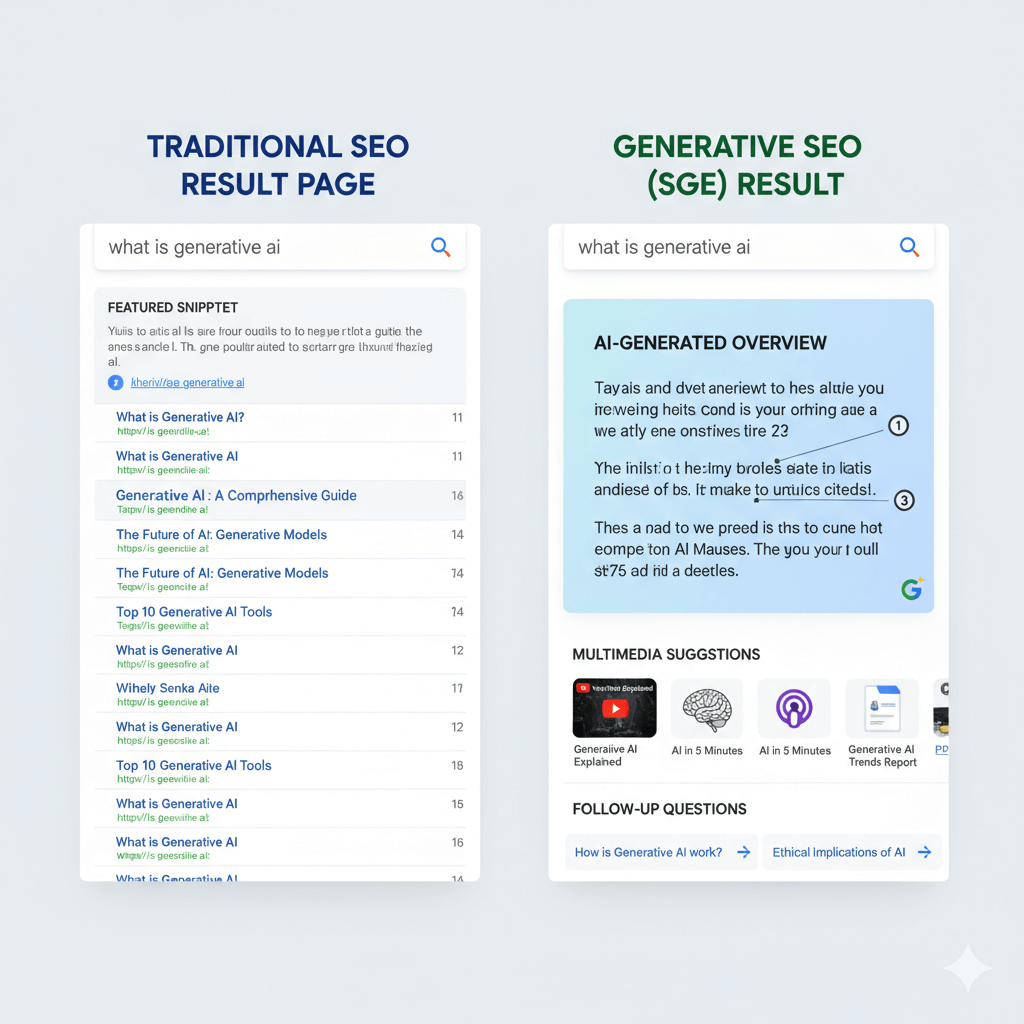
Trend 2: Short-Form Video Still Rules
If 2020–2024 was the era of “pivot to video,” then 2025-26 is the era of “you’re either doing video or you’re invisible.”
In India, short-form video is the undisputed king of attention. From Instagram Reels and YouTube Shorts to homegrown players like Moj and Josh, audiences are consuming snackable content at a scale that written blogs and static creatives simply cannot compete with.
Here’s what the data says:
- India spends over 4.9 hours/day on smartphones, with short-form content eating up a majority share.
- Reels consumption in Tier 2 and Tier 3 cities is outpacing metro adoption, making video not just a youth-culture thing, but a pan-India phenomenon.
- Influencer-led video commerce is booming: Meesho and Flipkart’s video-first strategies are showing 20–30% higher conversion rates compared to static catalogue marketing.
For brands, this isn’t just about posting funny clips—it’s about building a video-first marketing stack:
- Ads that blend in with organic content (native-style short videos).
- UGC-powered trust: Customers and micro-influencers talking about your product outperform high-budget shoots.
- Affiliate & Social Commerce: Video content tied directly to purchase flows (a trend TikTok Shop has perfected globally).
To understand how social media has evolved from scrolling to storytelling, explore our deep dive into the future of content – Social Media in 2025: Not Just a Platform, It’s a Personality Test.
Trend 3: Voice Search & Vernacular Content
India isn’t just an English-first internet market. With 22 officially recognized languages and hundreds of dialects, the country’s digital audience is diverse – and increasingly voice-driven.
Here’s why:
- Over 60% of Indian internet users are projected to prefer consuming content in regional or native languages (Hindi, Tamil, Bengali, Marathi, etc.).
(Based loosely on the current ~57% urban preferring regional content and rising trend) - Voice search adoption is accelerating: by 2026, more than half of Indian users may regularly use voice commands for search or tasks, thanks to improved NLP, cheaper devices, and better regional language support.
(One report predicts over 50% of users will adopt voice assistants by then.) - Vernacular content platforms (Dailyhunt, ShareChat, Moj, etc.) are now the default experience in many regions. With over 68% of users already preferring native-language content today, that share is expected to push into the 70–75% range by 2026.
For Indian brands, this trend isn’t optional. It’s about building trust and accessibility:
- Voice Commerce: Imagine someone in Jaipur saying, “Alexa, order basmati rice 5kg.” If your product isn’t optimized for voice search, you don’t exist in that buyer’s funnel.
- Regional SEO: Optimize keywords in Hindi or Tamil, not just English. A Ludhiana furniture shop may find more traction for “लुधियाना में सोफा सेट खरीदें” than “buy sofa set in Ludhiana.”
- Content Personalization: A health brand explaining diabetes care in Bengali via voice + video can outperform a national English campaign, simply because it resonates deeply.
👉 What this means:
- Don’t just translate – localize. Voice and vernacular are about cultural context, not word swaps.
- Invest in multilingual SEO and voice-optimized FAQs.
- Use AI transcription + translation tools (like Google’s Speech-to-Text or OpenAI Whisper) to scale vernacular content.
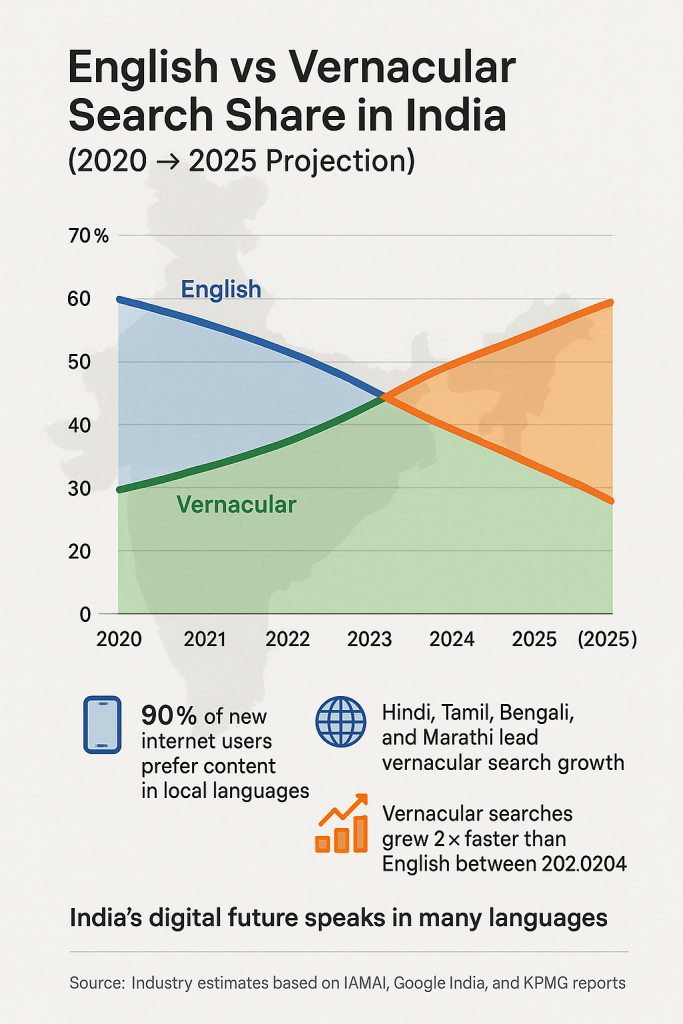
⚡ This trend is where India has a unique edge over Western markets – because brands that crack vernacular + voice now will dominate Tier 2 and Tier 3 cities tomorrow.
Trend 4: Social Commerce Goes Full-Fledged in India
Once upon a time, people used social platforms to scroll, laugh, and like. In 2026, many go there to spend. Social media is no longer just a place to build awareness – it’s a primary commerce channel, especially in India, where buyers now expect to go from discovery to checkout without ever leaving their favourite app.
Why This Matters in India
- Hyper-local commerce adoption: Meesho, GlowRoad, and Trell have proven that social-first shopping thrives in Tier 2, Tier 3, and even semi-rural markets. In some districts, influencer-led social shops already generate more revenue than traditional local retail.
- Integrated shopping within chat apps: WhatsApp’s shopping catalogue, in-chat checkout, and curated storefronts are now fully embedded in everyday conversations. When a user sees a product in an influencer Reel, they can add-to-cart inside WhatsApp without needing to open a browser.
- Platform convergence with commerce layers: Flipkart, Myntra, Amazon India, and even ShareChat are embedding short-video feeds, shoppable overlays, and social walls inside their apps. The lines between “social feed” and “product catalogue” are blurring.
What’s Fuelling It
- Micro-influencers as micro-retailers: Influencers with 5k–50k followers are now running mini-shops, hosting drops, and converting at rates of 10–15% in niche categories (e.g., regional fashion, ethnic wear, home décor). Because they speak dialects, show real-life use, and have high trust in local communities.
- Live commerce evolution: Indian platforms are experimenting with hybrid models – “live + asynchronous shopping.” Creators host livestreams, but the product listing stays open post-live for hours/days so latecomers can still purchase.
- Creator ecosystems & UGC commerce: Brands now seed micro-influencer kits and UGC templates so that real users become mini-vendors, stitching content and commerce.
- Seamless payments + instant credit: UPI, one-click wallets, BNPL, and embedded credit offerings mean friction is often removed before it happens.
Brand Playbook for 2026
- Design social-first catalogues & creative templates. Think vertical video catalogues, shoppable reels, and product overlays designed for feed immersion.
- Regional creators > National celebrities. A Tamil-speaking fashion creator driving Rs. X in Madurai may convert more than a pan-India campaign in Chennai. Match language, culture, and audience.
- Run live commerce pilots during events. Festivals like Navratri, Onam, Ganesh Chaturthi, and Diwali are prime opportunities. Use short livestreams with limited-offer drops to test conversion thresholds.
- Test asynchronous shopping windows. After a live event, keep the product feed open – many users discover it later and still convert.
- Measure beyond impressions. Track the full funnel: views → add to cart → completed purchase, not just reach or engagement.
Trend 5: AI-Powered Personalization at Scale
In 2026, personalization is no longer a “nice-to-have” – it’s the user experience baseline. Brands that still treat personalization as a campaign tactic will be outpaced by those who bake it into every touchpoint, in real time, across multiple channels.
For Indian brands – operating in a multilingual, multi-tier ecosystem with wide variance in consumer behaviour – AI personalization is the bridge between scale and relevance.
What’s New in 2026
- Zero-party / intent-based signals: Instead of inferring preferences, brands more often ask users directly (e.g., “Which skincare concern do you want to solve first?”), then feed that data into AI models for tailored recommendations.
- Multimodal personalization: AI systems today are combining text, image, voice, and behavioural signals to tailor product suggestions, landing page visuals, ad creative, and even UX flows – all in one experience.
- Cross-channel consistency: Whether a customer engages via WhatsApp, app, web, or social, the persona, tone, and offers adapt seamlessly. The brand “feels the same” everywhere.
- Predictive next-best actions: Beyond recommending products, AI now offers next-best messages, incentive nudges, and retention hooks. For example: “We see you typically reorder in 45 days – would you like a reminder or auto-reorder setup?”
Indian Context
- D2C beauty & wellness brands are using AI engines to custom-blend formulations based on user skin type, climate, and previous purchase behaviour.
- Edtech platforms are tailoring learning paths per user, generating regional language quizzes and follow-up modules based on performance.
- Regional ecommerce brands are using AI to adapt their product display based on location and regional preferences – for example, showing warmer clothing in the North during winter, and lighter fabrics in the South during the same period, even on the same campaign.
- Brands using AI chat / conversational flows (on WhatsApp or in-app) inject personalization in real time – “Hey, I see you looked at shoes in grey before. Want to see new grey arrivals?”
Brand Playbook for 2026
- Start with the right data architecture. Clean first-party data, unified CDP, behaviour logs, user signals – all feeding your AI brain.
- Employ tiered models. Use “fast” lightweight models for day-to-day personalization and “deep” models for heavy lifts (e.g., re-engagement, predictive loyalty).
- Always A/B test. Even AI decisions need validation. Test variations in message, channel, incentive and visuals.
- Keep human override. Let AI suggest, humans refine. Prevent tone meltdown or context misfires.
- Experiment in phases. Begin with email or retargeting, where margins are safer, then graduate to homepage and live chat personalization.
If you’ve ever wondered how brands train machines to think creatively, our breakdown of prompt literacy makes it clear – Prompt is the New Literacy: How Words Became Code
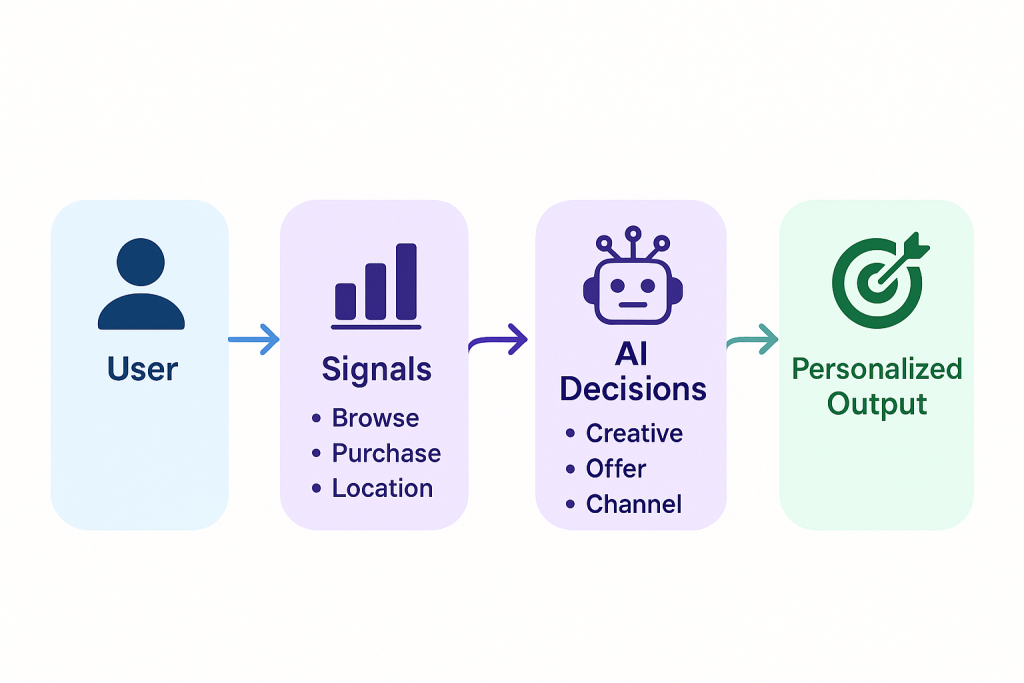
| Channel | Personalization Type | Tools / Example Brands |
| Email & SMS | Dynamic content blocks, predicted offers | Klaviyo, MoEngage, Gupshup |
| Website & App | Component-level personalization (images, copy) | DynamicYield, Salesforce Personalization |
| Chatbots / Conversational | Real-time personalized responses | Landbot, Botpress, WhatsApp API + AI |
Trend 6: Virtual Influencers & AI Avatars – The New Brand Ambassadors
In 2026, the influencer economy has a twin: AI-generated personalities that never sleep, age, or get cancelled.
Meet Kyra, Zenia, and a growing roster of digital faces designed to charm your audience. These aren’t just Instagram curiosities anymore – they’re a scalable marketing infrastructure.
Why It Matters in 2026
- Always-on Presence: Virtual influencers can appear in multiple campaigns simultaneously, respond instantly to followers, and maintain consistent tone and aesthetics across languages.
- Cost & Risk Efficiency: After the initial investment (₹5–10 lakhs to develop a high-fidelity avatar), ongoing campaign costs drop dramatically. No photoshoots, no travel, no “PR damage.”
- Cross-language Adaptability: AI avatars can speak Hindi, Tamil, Bengali, or English fluently – with accent and cultural context tuned per audience.
Indian Context
- Kyra (India’s first virtual influencer) now partners with lifestyle and tech brands. Others like RAI (Reliance’s experimental avatar) and Tara (an AI travel creator) are emerging.
- Brands are merging AI livestreaming + voice cloning for interactive product demos on platforms like Amazon Live and YouTube.
- Even government campaigns (tourism, health, education) are exploring avatar-led explainers to reach younger audiences.
Brand Playbook for 2026
- Mix human + AI talent: Use human creators for relatability, avatars for scalability and creative experimentation.
- Localized personas: Imagine an AI influencer celebrating Onam in Malayalam or Lohri in Punjabi – hyper-local storytelling without reshoots.
- Co-create campaigns: Invite followers to help design or name the avatar – engagement through participation, not passivity.
Trend 7: Affiliate Marketing 2.0 – Powered by Video and Trust
Affiliate marketing in India has shed its coupon-code skin. In 2026, it’s a video-first, influencer-driven performance engine, built on authenticity and real-time conversion data.
What’s Changed
- Short-form Affiliate Videos: Instead of text links, creators now drop personalized Reels or Shorts with embedded product tags and instant checkout links.
- AI Attribution Models: Tools now identify which influencer or video drove the sale, even if the user converted days later on a different device.
- Creator Monetization 2.0: Platforms like YouTube Shopping, Instagram Collab Shops, and Flipkart Creator Studio provide transparent revenue dashboards for affiliates.
Indian Context
- Regional Influencer Networks are the new affiliate marketplaces. Bhojpuri, Tamil, and Marathi creators are running micro-affiliate stores that outperform traditional banner networks.
- Fintech integration: BNPL (Buy Now Pay Later) and micro-credit options through UPI enhance average order values.
- Performance Benchmark: Indian video affiliates are clocking conversion rates between 6–10%, nearly double the rate of banner-based affiliate ads in 2023.
Brand Playbook for 2026
- Empower micro-creators: Supply ready-made content kits, tracking links, and AI-generated thumbnail options.
- Track ROI holistically: Move beyond “link clicks.” Combine platform analytics with CRM to calculate lifetime value per creator.
- Build affiliate loyalty: Offer tiered rewards, creators who hit targets earn exclusive drops, early access, or co-branded content rights.
Trend 8: Privacy-First Marketing & First-Party Data – The New Currency
In 2026, data privacy isn’t a regulatory checkbox – it’s a competitive moat. Third-party cookies are dead, IDFA limitations are stricter, and global consumers (especially Indian millennials and Gen Z) demand control over how their data is used. For Indian brands, owning your data – not renting it – is no longer an advantage. It’s mandatory.
What’s Changing
- Third-party cookie embargo is real: Most browsers now block third-party tracking by default. Without a robust first-party data strategy, your attribution, retargeting, and personalized experience break.
- Zero- and first-party signals dominate: Brands ask users directly (surveys, preference centers, quizzes), collect consented signals (like interests, product preferences), and then layer in behaviour (purchase, browse) to build rich profiles.
- Privacy frameworks & compliance as trust signals: Brands that transparently declare what they do with data – e.g., “I will never share your data outside our group” – are winning loyalty in India’s privacy-conscious cohort.
- Federated & on-device learning: AI personalization is shifting from cloud to edge – models process data on-device, reducing data movement and improving privacy.
Indian Context
- Many Indian brands now use WhatsApp opt-ins and SMS preference centers to build first-party lists in a channel consumers trust.
- Startups in fintech, health, and edtech aren’t just complying with data laws – they use strong privacy as a brand differentiator.
- Brands that move in Tier 2/3 cities deploy minimal-data personalization (e.g. “Did you prefer ratings > 4★?” instead of full browsing history) to balance local trust with relevance.
Brand Playbook for 2026
- Build your data house first: On your website, app, and chat – create consented preference centres, product quizzes, and logins that capture zero- and first-party signals.
- Segment with transparency: Label segments clearly – e.g., “sports enthusiast, fashion interest, phone upgrade cycle” – so customers see how their preferences are used.
- Layer with behavioural signals: Then combine browsing, add-to-cart, purchase behaviour to refine personalization – but only after consent.
- Test privacy-safe attribution models: Use server-side tracking, aggregated modelling, and collaboration tools (e.g., Meta’s Conversions API, Google’s Enhanced Conversions) instead of relying solely on cookie-based paths.
- Communicate your data promise: Show a simple banner or footer: “Your data is used to personalize your experience. You control what we store.” That transparency becomes a trust badge.
Balancing personalization and privacy is tricky but the future belongs to those who learn to make AI accountable. Check out our blog to learn more – How AI Branding Tools Are Changing Personalized Marketing Forever
Trend 9: Omnichannel Experience – Where Online and Offline Finally Merge
In 2026, the word “channel” is becoming obsolete. Shoppers don’t think in terms of online or offline anymore – they think in terms of continuity. The winning brands are those that make discovery, decision, and delivery feel like one continuous conversation.
What’s Driving It
- Unified identity systems: Thanks to UPI-linked logins and cross-device data stitching, brands can now recognize a shopper seamlessly whether they browse your website, walk into your store, or DM you on Instagram.
- Connected storefronts: POS systems sync instantly with e-commerce inventory. If an item is sold out online but available in-store, customers can reserve it via WhatsApp or your app.
- “Phygital” experiences: AR mirrors, QR-enabled packaging, and in-store NFC tags make offline experiences digitally measurable.
- Real-time customer support: Conversational AI now powers unified chat threads – whether the message started on WhatsApp, your website, or your delivery tracker.
Indian Context
- Reliance Retail, Tata Neu, and Nykaa have become the templates: integrated loyalty programs, shared wallets, and app-to-store coordination.
- Mid-sized D2C brands are building micro-warehouses and dark stores to fulfil local orders within hours, blending e-commerce speed with local familiarity.
- Regional retailers are using WhatsApp + Shopify integrations to convert walk-ins into repeat digital buyers.
Brand Playbook for 2026
- Map customer journeys holistically: Identify every touchpoint from first view to post-purchase support; make each step feel consistent in tone and response time.
- Sync loyalty across channels: One wallet, one point system, one customer ID – whether online or offline.
- Use location intelligence: Push nearby-store offers or same-day pickup prompts to app users within specific pin codes.
- Train teams for continuity: A WhatsApp inquiry should be visible to the in-store salesperson before the customer even walks in.
- Comparison Table:
| Brand | Key Omnichannel Feature | Impact |
| Reliance Retail | Unified loyalty & payment ID | 25% repeat-purchase lift |
| Nykaa | Store pickup + app sync | 18% faster fulfillment |
| D2C Fashion Brand | WhatsApp integrated order system | 3× retention boost |
Trend 10: Automation in Performance Marketing – Smart Campaigns, Human Strategy
In 2026, performance marketing isn’t about who can tweak bids the fastest – it’s about who can train their AI the smartest.
The rise of machine learning–powered ad systems has turned campaign optimization into a science of feedback loops. Platforms like Google Ads, Meta Advantage+, Amazon DSP, and LinkedIn Smart Bidding now manage billions of micro-decisions per second – deciding who to show your ad to, when, where, and at what cost. The new game? Teaching these systems your brand’s context better than your competition does.
What’s Changing
- Full-Funnel Automation: Campaigns now learn from both top-of-funnel (engagement) and bottom-of-funnel (conversion) events, using unified attribution models. AI reads signals from search, display, and shopping ads simultaneously to allocate budgets dynamically.
- Predictive Budgeting: Algorithms can forecast ad performance up to a week ahead based on weather, seasonality, and behavioural data. For instance, AI predicts when demand for umbrellas will spike before monsoon hits Mumbai – and shifts ad budgets pre-emptively.
- Creative-Level Optimization: Generative AI tools are now embedded into ad dashboards. Meta’s Advantage+ and Google’s Performance Max auto-generate creatives, test multiple combinations, and adapt copy to region, device, or even browsing intent.
- Voice & Conversational Ads: Smart speakers, podcasts, and voice search ads are becoming new frontiers. Ads are delivered as interactive voice prompts instead of static text.
Indian Context
- Brands are shifting toward AI-managed media buying: 70%+ of Google Ads in India now run under automated bidding models.
- Regional ad optimization is becoming standard: Meta’s systems can auto-translate creatives into eight Indian languages while maintaining tone.
- Retail media automation (like Amazon Ads, Flipkart Ads) is growing fastest – brands now auto-manage product placements, dynamic pricing, and sponsored listings with minimal human intervention.
- Agencies are evolving: Instead of campaign execution, their core value lies in training AI systems with better data inputs, customer segmentation, and creative direction.
Automation may handle your dashboards, but storytelling still builds trust.
Here’s how we connect both in our work.
👉 From Click to Cart: How We Build E-commerce That Sells Everywhere.
Brand Playbook for 2026
- Feed clean data: Garbage in, garbage out. Ensure conversion tracking, CRM integrations, and accurate tagging so automation can make intelligent decisions.
- Human-AI collaboration: Let automation handle scale; let humans guide storytelling, differentiation, and brand positioning.
- Experiment in micro-bursts: Run short automated test campaigns, evaluate, and re-train the AI models continuously.
- Cross-platform orchestration: Sync Google Performance Max, Meta Advantage+, and Amazon DSP data to maintain a unified learning loop.
- Avoid over-reliance: Automation without human oversight risks ad fatigue or tone mismatch. Audit regularly to prevent brand drift.
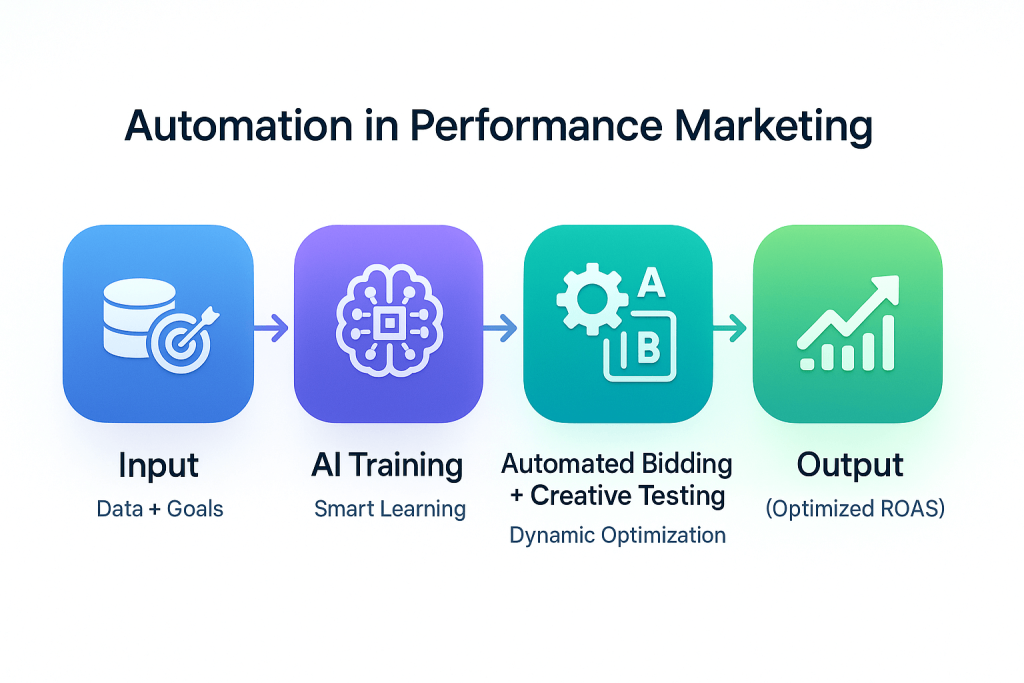
| Platform | Automation Tool | Key Function | Indian Adoption 2026 |
| Google Ads | Performance Max | Predictive Bidding + Asset Mix | 80%+ campaigns |
| Meta Ads | Advantage+ | Auto Creative Optimization | 75%+ advertisers |
| Amazon Ads | Sponsored AI | Retail Media Automation | 60%+ brands |
Trend 11: Programmatic DOOH – Billboards That Think Like Algorithms
In 2026, outdoor advertising is finally catching up to digital intelligence. The billboards you see on highways and in metro stations are no longer dumb screens looping generic ads – they’re programmatic, data-fed, and in many cases, contextually alive.
Imagine a digital hoarding in Bandra switching from a coffee ad to an umbrella sale when it detects rising humidity. Or a billboard near a university automatically showing fintech job openings at 9 a.m. on weekdays. That’s not imagination anymore—it’s standard practice in India’s top metros.
What’s Changing
- Data-driven triggers: DOOH systems now integrate with weather APIs, traffic density data, and even live event schedules to auto-select which creatives to display.
- Dynamic creative insertion: Just like online display ads, outdoor creatives are now dynamically rendered in real-time – optimizing for audience type, location, and time of day.
- AI-based bidding: Brands can now bid programmatically for screen time in real-world spaces (via platforms like Lemma, Times OOH, and Moving Walls). The system prioritizes high-footfall locations at high-conversion hours.
- Measurement maturity: Cameras and anonymized sensors track engagement metrics such as dwell time, impressions, and conversion proxies (e.g., nearby mobile activity).
Indian Context
- India’s programmatic DOOH market is valued at over ₹1,500 crore in 2026, growing at 20–25% YoY as digital infrastructure expands to Tier 2 cities.
- Smart city projects (Delhi, Pune, Hyderabad) have integrated digital signage networks into civic data systems, letting advertisers buy hyper-local ad slots dynamically.
- Retail giants and D2C brands use DOOH retargeting – if someone saw a product ad outdoors and later visited the brand’s site, AI links those signals through geo-based mobile IDs.
Brand Playbook for 2026
- Link your DOOH to digital: Use QR codes, NFC tags, or geo-retargeting pixels to continue the conversation from street to screen.
- Set contextual rules: Trigger your creative based on weather, time, or events – e.g., “Show sunglasses ads when local temperature ≥ 32 °C and local time is 10:00 – 16:00.”
- Test hybrid campaigns: Run synchronised bursts – launch your outdoor ad and digital push within the same 3-hour window to double visibility.
- Measure beyond eyeballs: Track engagement lift, store visits, or app downloads from exposed geolocations.
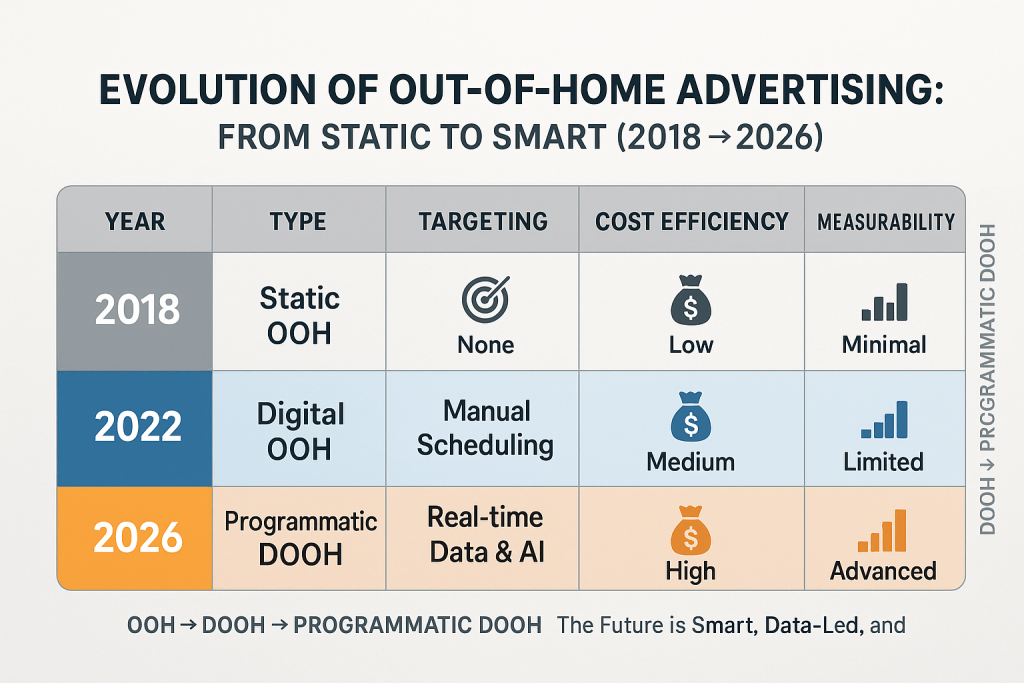
Trend 12: AR/VR & Experiential Marketing – From Attention to Immersion
In 2026, engagement isn’t measured by clicks or views – it’s measured by presence.
The brands winning hearts (and wallets) are the ones turning marketing into an experience, not just an impression.
Thanks to mainstream AR glasses, faster 5G, and cheaper VR hardware, the metaverse dream didn’t vanish; it evolved quietly into everyday immersive marketing.
What’s Changing
- Augmented Reality (AR) Becomes Default:
AR is no longer just a Snapchat filter gimmick. Indian consumers now “try on” furniture in their homes, preview paint shades on walls, and visualize jewellery or eyewear with precision.
IKEA, Lenskart, and Tanishq are using AR not for novelty but for conversion – customers who use try-on features show 30–40 % higher purchase intent. - Virtual Showrooms & 3D Commerce:
D2C brands are building lightweight VR showrooms where customers can explore collections like walking through a digital store. No headset required – mobile gyroscope + WebGL does the trick. - Hybrid Events (Phygital 2.0):
Product launches blend real and virtual audiences. A new sneaker drops simultaneously at a Mumbai pop-up and in a VR event where avatars queue up for digital collectibles (NFTs now rebranded as “authenticity tokens”). - Sensory Marketing & Haptics:
Early pilots in experiential retail – like car brands offering AR-enabled steering feel simulations via phone vibration – re-redefining pre-purchase exploration.
Indian Context
- 5G + Make-in-India devices have made AR experiences accessible on mid-range phones; over 250 million Indian users interacted with AR filters or lenses at least once in 2025.
- Fashion & Beauty AR is booming: Nykaa and Myntra now integrate virtual try-ons natively, while smaller labels use Snapchat Lens Studio for low-cost immersive campaigns.
- Real-estate VR tours are standard – from Gurugram to Kochi, property listings come with immersive walk-throughs powered by Indian SaaS startups.
- Education & tourism leverage AR storytelling: scanning a monument’s QR brings up a holographic guide narrating its history in the regional language.
Brand Playbook for 2026
- Start small, scale smart: Pilot AR filters or try-on tools for your best-selling SKUs before full deployment.
- Think utility over flash: Every immersive element should help users decide or engage deeper—not just amuse them.
- Connect phygital touchpoints: Let users scan packaging, posters, or billboards to unlock digital experiences or rewards.
- Measure engagement beyond impressions: Track dwell-time, interactions, and assisted conversions instead of vanity reach.
Trend 13: Sustainability & Ethical Branding – Because Planet > Platform
By 2026, “green” is no longer a colour – it’s a KPI.
Consumers (especially India’s under-35 crowd) now measure a brand’s worth not just by how clever its ads are, but by how clean its conscience is.
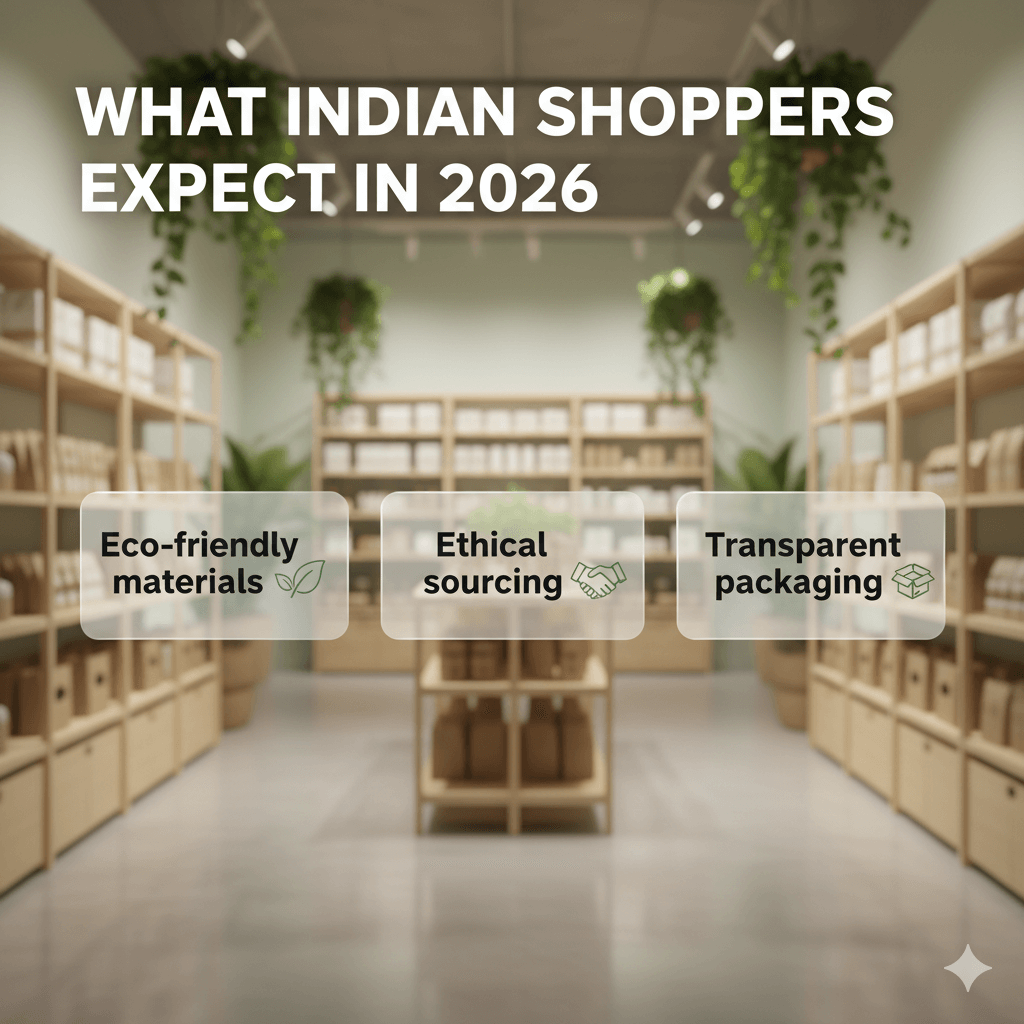
What’s Changing
- Carbon-conscious marketing: Brands track campaign emissions just like CTRs. Agencies now present dashboards showing “impression per watt” alongside “cost per click.”
- Circular commerce: Refurbished, recyclable, or low-waste products are finding pride of place in digital storefronts. Amazon India’s “Second Chance” store is seeing double-digit month-on-month growth.
- Purpose > Pitch: Consumers scroll past slogans like “go green” and stop at proof – ESG data, factory transparency, or visible sustainability initiatives.
- AI for good: AI is helping reduce wastage – predicting inventory, optimizing logistics, and even lowering energy usage in data centres.
Indian Context
- Indian Gen Z shoppers (roughly 60 million online buyers) say they’ll pay more for eco-friendly products.
- D2C labels like Bare Anatomy and No Nasties proudly list their sourcing impact.
- Major FMCG players are integrating QR-based traceability – scan a code to see the product’s supply chain.
- Influencers are turning into “eco-advocates,” doing collabs around reuse, thrift, and conscious consumption.
Brand Playbook for 2026
- Show receipts: Move beyond buzzwords – publish your sustainability metrics or impact reports.
- Gamify sustainability: Reward customers for recycling, refilling, or choosing slower shipping.
- Educate with charm: Combine humour + sincerity; think memes that say “Save the Earth, it’s the only one with Wi-Fi.”
- Collaborate for scale: Partner with NGOs or government initiatives for credibility and reach.
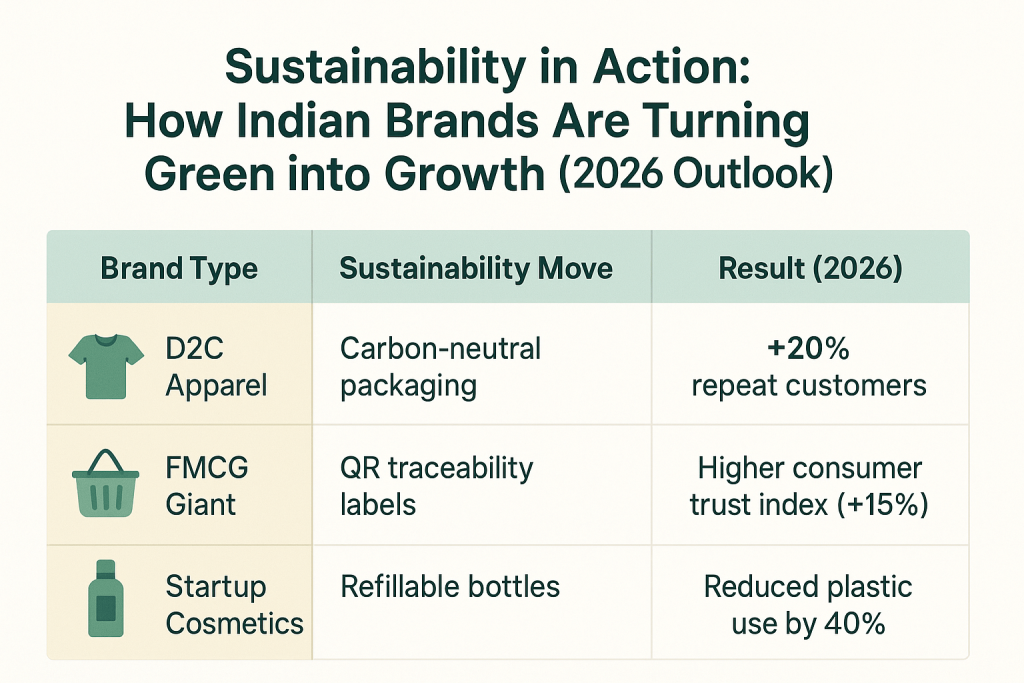
For a deeper look at how creativity and conscience co-exist in marketing, revisit our exploration of digital authenticity:
👉 How to Choose the Best Digital Marketing Agency in India
In conclusion
So, here we are – 13 trends later.
AI writes your copy, avatars sell your clothes, billboards talk to satellites, and somehow, amidst all the code and chaos, human connection is still the ultimate marketing currency.
2026 isn’t just about smarter algorithms – it’s about smarter empathy. The brands that win won’t be the ones shouting the loudest, but the ones listening the closest.
Because when the dust settles, and the pixels fade, your customer won’t remember your CTR.
They’ll remember how your brand made them feel – on screen, on the street, or on planet Earth.
So, keep your data clean, your campaigns greener, and your tone just the right amount of cheeky.
After all, this isn’t the end of digital marketing – it’s the sequel. And this time, the plot’s written in both code and conscience.
